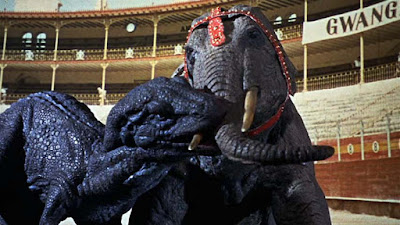In the late 1960s, adventure and sci-fi films weren't all too popular in the theaters. The younger generation preferred films that portrayed gritty realism; films that dealt with problems they could relate to. The older generation were wondering what became of the musicals and noirs they loved and preferred to stay at home watching their favorite old-time actors on the late-late movie on television.
Hence, a fantasy-western like The Valley of Gwangi - even with the name of Ray Harryhausen behind it - was destined for instant obscurity. Today, it is still buried under the stop-motion maestro's other works.
The Valley of Gwangi features an imaginative story line and - naturally - some great special effects, but it doesn't come off as particularly entertaining fare, partly owing to the bland performances of the two main leads, James Franciscus and Gila Golan ( which sounds like a Harryhausen creature itself ).
The story begins in the desert of Mexico where a gypsy steals a small creature known as "El Diablo" from the Forbidden Valley. This turns out to be the miniature prehistoric ancestor to the modern horse. T.J Breckenridge ( Golan ) gets a hold of this creature and hopes to feature it in an upcoming act for her travelling circus. When paleontologist Horace Bromley ( Laurence Naismith ) hears about this find, he convinces a band of gypsies to steal it and return it to the Forbidden Valley so he can discover if more of these creatures exist. Tuck Kirby ( Franciscus ) follows these gypsies into the valley attempting to re-capture El Diablo for Breckenridge.....but instead discovers a litany of living dinosaurs! Along with other members of the circus, Kirby and Professor Bromley try to capture Gwangi, a belligerent Allosaurus, to make the starring attraction of the circus instead.
Ultimately, what rescues The Valley of Gwangi from becoming a quick drive-in picture is the exciting theme music ( by Jerome Moross ), and the visual style of the film....scenes of the professor in the desert hunting for dinosaur bones, close-ups of the old gypsy woman uttering curses, and Gwangi struggling to free himself from the metal cage at the circus. Harryhausen's animation during the final sequence within the church is especially good, too.
After the release of Gwangi, Harryhausen and producer Charles Schneer began work on The Golden Voyage of Sinbad ( 1973 ), a film that took several years to produce but which proved to be a much bigger success at the box-office.




No comments:
Post a Comment